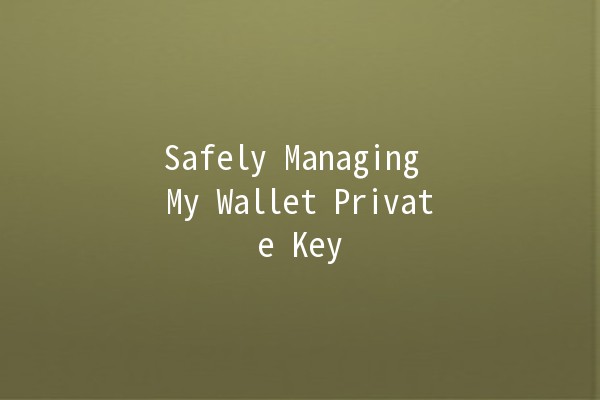
In the everevolving world of cryptocurrency, keeping your private key secure is paramount. Understanding and implementing strategies for private key management can mean the difference between retaining access to your funds and potentially losing everything. This article delves into effective methods for managing your wallet's private key securely while also highlighting productivityenhancing techniques.
Understanding the Private Key
Before we dive into management strategies, it is crucial to comprehend what a private key is. A private key is a cryptographic code that allows you to access and control your cryptocurrency. Think of it as a secret password that proves your ownership over your digital assets. If your private key is compromised, anyone can access your wallet and transfer your funds without your consent. Therefore, securing your private key is of utmost importance.
Why Managing Your Private Key Matters
Best Practices for Private Key Management
To help you securely manage your wallet’s private key, follow these essential tips:

Generating a strong private key is your first line of defense. Use a random key generator that produces lengthy passwords comprising numbers, letters (both uppercase and lowercase), and special characters.
Application Example: Instead of using a simple key like "123456", generate a key like "G3b#q6Lm@n1!qD8Z" using tools such as Bitaddress.org or hardware wallets.
Storing your private key offline significantly reduces the risk of cyberattacks. Hardware wallets or paper wallets are popular methods for offline storage.
Application Example: You can use a hardware wallet like Ledger Nano S, which keeps your private key stored securely in a physical device, away from the reach of potential hackers. Alternatively, you could print your private key on paper and store it in a safe place.
Adding an additional layer of security through password protection can make it more difficult for unauthorized users to access your keys. Ensure to use twofactor authentication (2FA) whenever possible.
Application Example: Set up 2FA using applications like Google Authenticator or Authy. This can protect your wallet even if someone manages to obtain your private key.
Being aware of phishing tactics means you can protect yourself and your assets. Cybercriminals often try to trick users into giving away their private keys.
Application Example: Always doublecheck the URLs of sites you visit, make sure they are secure (https://), and avoid clicking on links from unverified sources. Familiarize yourself with common phishing strategies so you can recognize potential threats.
Regularly backing up your private key data ensures that you won’t lose access to your coins due to device failure or accidental deletion.
Application Example: Use cloud storage with strong encryption or secure USB drives to back up your wallet. Ensure these backups are stored in multiple locations, such as a safe at home or a safety deposit box at the bank.
Additional Productivity Tips
In addition to the primary focus of this article on securing your private key, implementing these productivityenhancing techniques can streamline your cryptocurrency management process:
Stay organized by using portfolio management applications to keep track of your assets and their performance. These tools can provide insights and analytics, aiding in better decisionmaking.
Set a regular schedule for reviewing your security practices. This includes updating passwords and checking for potential breaches or updates in cryptocurrency security protocols.
Keep a detailed log of all your transactions, including dates, amounts, and the wallets involved. This practice can help you keep track of your activity and spot any irregularities.
Stay informed by participating in cryptocurrency forums and communities. Engaging with others can provide insights into best practices and emerging threats, enhancing your knowledge base.
Automate alerts for transactions and updates related to your cryptocurrencies. This can keep you informed of any unusual activity related to your wallets.
Common Concerns About Private Key Management
Losing your private key means you cannot access your assets anymore. This is why secure management and regular backups are essential.
Yes, if it is stored online or if you fall victim to phishing attacks, your private key can be hacked. This is why it is vital to implement offline storage and be educated about security practices.
The safest storage methods include using hardware wallets and paper wallets, which keep your key offline and significantly reduce exposure to online threats.
While you don’t need to change your private key often, it is a good practice to do so after a notable event, such as using your key or if you suspect potential compromise.
Yes, recommended tools include hardware wallets like Ledger and Trezor, and secure password managers that allow encrypted storage of your keys.
Unfortunately, if you lose your private key and have not made backups, recovering it is typically impossible. This highlights the importance of regular backups.
By incorporating these practices and maintaining an active approach to your private key management, you can significantly enhance the security of your cryptocurrencies and safeguard against potential losses. Following these strategies ensures that you maintain control over your digital assets—defending against the vulnerabilities present in the cryptocurrency space today.

